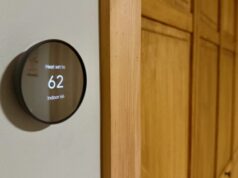
Motion sensors are one of the most practical and cost-effective ways to improve safety, convenience and energy efficiency in the home. Whether you’re looking to automate your lighting, boost your home security or cut down on power bills, these compact devices can play a big role in how your home functions.
They’re commonly used in areas like driveways, hallways and outdoor zones, but motion sensors can be integrated into almost any part of your electrical or home automation system.
Here’s what you need to know before installing motion sensors in your home.
How do motion sensors work?
Motion sensors detect movement within a certain range and trigger an action when movement is detected—most commonly turning a light or device on or off. They do this using one of several sensing technologies, the most common being passive infrared (PIR). PIR sensors detect changes in heat patterns caused by moving bodies, like a person walking past.
Some sensors combine infrared with other methods like microwave or ultrasonic sensing, which allows for greater accuracy or coverage. More advanced models can even differentiate between types of motion, helping avoid false triggers caused by pets, weather or passing cars.
Where are motion sensors used?
Motion sensors are incredibly versatile and can be installed indoors or outdoors, wired or wireless, standalone or integrated into smart home systems.
Common residential applications include:
- Outdoor lighting: Motion-activated floodlights are a popular choice for driveways, backyards and entrances. They deter intruders while offering added convenience when arriving home at night.
- Hallways and stairwells: Installing sensors in transitional spaces ensures lights only turn on when someone is moving through the area, ideal for nighttime trips or households with kids.
- Bathrooms and laundries: These rooms are often forgotten when it comes to lighting control. Sensors can ensure lights automatically switch off when the room is empty, saving energy.
- Garages and sheds: Motion detection in rarely used or isolated spaces adds both safety and practicality.
- Security systems: Motion sensors are an essential component of most monitored or self-managed home security setups.
If you’re building or renovating, motion sensors can be incorporated into your lighting plan or connected to a broader smart home system.
Types of motion sensors
The right type of sensor depends on where and how you plan to use it. Here are the most common options:
- Passive infrared (PIR): The most widely used type, especially for lighting. Works best for detecting movement across the sensor’s field of view.
- Microwave sensors: Send out microwave pulses and detect their reflection. Can cover larger areas but are more prone to false alarms.
- Ultrasonic sensors: Emit high-frequency sound waves and detect motion based on how these waves bounce back. Often used in commercial settings.
- Dual-tech sensors: Combine PIR and microwave for improved reliability. Less likely to trigger accidentally.
Some motion sensors are built into light fittings or switches, while others are standalone units you can mount on walls or ceilings. There are also smart versions available that let you customise settings, link devices together or receive alerts via your phone.
Benefits of motion sensors
Energy efficiency is one of the biggest benefits of motion sensor lighting. By ensuring lights only operate when needed, you can dramatically reduce your energy use, especially in areas where lights are often left on accidentally. Motion sensors are a smart addition when trying to lower the running costs of your lighting.
They also enhance home security, deterring intruders by automatically lighting up vulnerable or hidden areas like side paths, backyards or driveways.
Motion sensors are also ideal for hands-free convenience. In homes with young children, elderly occupants or accessibility needs, motion-activated lighting can be a simple way to improve usability and comfort.
When integrated into energy management systems, motion sensors become even more powerful, helping coordinate lighting, heating and appliance usage based on occupancy.
Things to consider before installing
While motion sensors are a great addition to many homes, they’re not foolproof. Incorrect placement can result in lights switching on unnecessarily, or worse, not activating at all when needed.
Here are a few things to keep in mind:
- Sensor range and angle: Ensure the sensor can “see” the area you want covered. PIR sensors, for instance, work best when movement occurs across their field of view, not directly toward them.
- Environmental factors: Trees, pets, heat sources and reflective surfaces can all impact sensor performance. For outdoor use, look for weatherproof models.
- Manual overrides: In some rooms, like bathrooms or kitchens, you may want the option to manually turn the lights on or off in case the sensor doesn’t behave as expected.
- Wiring and compatibility: Retrofitting motion sensors into older homes might require wiring adjustments. If you’re building new, speak with your electrician during the construction planning phase about incorporating sensors early.
Smart integration and automation
Today’s motion sensors are no longer limited to simply turning lights on and off. When integrated into a smart home system, they can trigger a wide range of actions, like adjusting heating, sending alerts to your phone or activating cameras. They’re especially powerful when used alongside other automation devices such as timers, light sensors or voice assistants.
In summary
Motion sensors are a simple but smart way to improve your home’s lighting, safety and energy use. Whether you’re upgrading your existing setup or building from scratch, motion sensors are worth considering, particularly in areas where lights are often forgotten or where visibility is important for security.
Used well, they help you cut power costs, reduce unnecessary energy use and make everyday life just that little bit easier.





